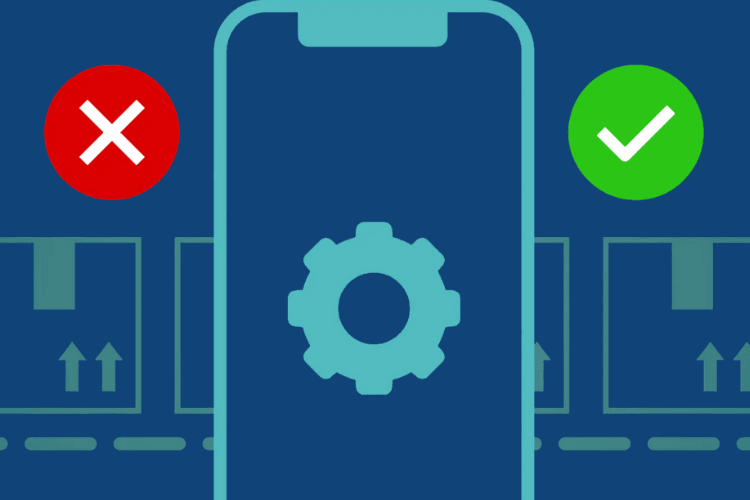Opening an e-commerce business is both exciting & overwhelming. With multiple e-commerce platforms available, selecting the right one is the best decision for startup success. When designing an online store, make sure it is scalable and secure. Shopify store development stands out as the top selection for global entrepreneurs.
Due to increased reliance on mobile shopping, users are more comfortable making direct purchases from their smartphones. Optimizing the Shopify store becomes the top priority if you want a sales boost. Slow loading time can frustrate customers, whether it’s a website/mobile app. Poor Shopify apps lead to a higher bounce rate & impact revenue.
Having a sluggish app can lose your customer, so Shopify apps deserve more attention. Testing the Shopify mobile application ensures reliability, performance, limits errors & ensures maximum uptime. In the following blog, we have discussed actionable tactics to incorporate into your Shopify application testing services.
I. Understanding the Shopify Mobile Ecosystem

Designing a mobile app for a Shopify store is the fastest way to enhance conversion rate and improve order values. Shopify offers a comprehensive solution for both startups & enterprises. Anyone who wants to design a functional e-commerce store without requiring any technical expertise selects Shopify. To know how Shopify application testing services help you to grow & succeed in the competitive e-commerce market, read the following statistics:
- Around 5.6 million active stores in more than 175 countries are hosted by Shopify as of 2024.
- The platform is becoming more and more popular; in 2024, there will be 20% more Shopify stores, demonstrating its expanding global usage.
- In 2024, 875 million people globally transacted with Shopify merchants.
- Approximately 30% of weekly internet shoppers in 2023 utilized a smartphone for buying.
- The U.S. market's mobile shopping spending is expected to reach $856 billion by 2027, making up a significant portion of e-commerce sales.
- According to recent surveys, 76% of respondents have used their phones to make transactions.
To attract more & more users to your site, ensure your site is loading quickly and compatible on every device. Hope the following statistics encourage you to choose Shopify mobile app testing services to launch your next e-commerce app.
1.1. Types of Shopify Mobile Apps
Merchant-facing apps (Shopify admin apps)
Digital platforms, usually seen on mobile devices, known as merchant-facing apps, are made to assist companies in managing and expanding their operations. These Shopify mobile applications are responsible for tasks such as taking payments, keeping track of sales, controlling inventories, and communicating with clients. With features like real-time sales dashboards, inventory alerts, CRM tools, and payment acceptance, these apps simplify corporate procedures.
Customer-facing apps (eCommerce storefronts, custom apps)
Applications that interact with customers help the Omnichannel strategy by offering a unified brand experience across many touchpoints and platforms. Customers may move between mobile apps, websites, and physical stores with ease thanks to the integration of data from several channels.
1.2. Common Challenges in Mobile App Testing for Shopify
Frequent updates and integrations
To address bugs, add new features, and maintain compatibility with the most recent OS versions, mobile apps need to be updated frequently. Regression testing is a critical component of the testing process since it ensures that these modifications do not cause new problems. Numerous mobile applications incorporate third-party services, such as analytics tools and digital media networks. Extensive testing is necessary to ensure smooth integration with these services and confirm that the application communicates with external systems as expected.
Varying device compatibility
With thousands of devices with varying screen sizes, resolutions, and aspect ratios, the mobile device industry is extremely fragmented. Given that users come across a wide range of screen sizes, aspect ratios, and pixel densities, screen sizes pose one of the most significant testing issues for mobile apps.
Layout, readability, and functionality are all impacted by screen sizes. Testing single devices does not ensure that other devices with various aspect ratios will work similarly. However, teams had to take different display sizes into consideration, which also made testing more difficult.
You should test on a variety of devices to verify compatibility with varying screen sizes and aspect ratios in order to address these issues. The layout of the app may be adjusted to fit all screen sizes by using responsive design concepts. This method produces more accurate findings by evaluating the effects of various screen conditions on app performance.
Handling real-time data and traffic spikes
In mobile application testing services, it can be hard to replicate every situation users might encounter, making it tough to simulate real-world settings. Simulated environments that replicate different elements, such as network speeds, geographic regions, etc., are used to test mobile apps.
Simulations may not accurately represent user conditions, even if they might be useful in evaluating some real-world problems based on data and usage patterns. Particularly when you're entering new markets, simulations depend on developers' perceptions of the user experience, which can be constrained.
II. Key Areas to Focus on While Testing Shopify Mobile Apps
2.1. Functional Testing
Functional app testing services are essential in the field of mobile e-commerce. The comprehensive audit guarantees that every feature works flawlessly, from the first user's login to the completion of a purchase. A malfunction can lower customer retention rates, damage the brand, and cause cart abandonment.
Because it compares the app's functionality to user expectations in real-world situations, functional testing is essential. Verifying the accuracy of the code is only one aspect of it; another is making sure that the end-to-end experience, user flow, and business logic all precisely match the needs of the client.
2.2. Performance Testing
To make sure an e-commerce mobile application can withstand real-world usage, particularly during moments of high purchasing demand, performance testing is essential. This kind of mobile app testing service is essential for a number of reasons, including robustness and user retention. The backend systems may be strained by an increase in user activity during sales or promotional events.

Performance testing aids in determining an application's and its backend infrastructure's maximum working capability. It's well known that mobile users don't tolerate sluggish apps. When an app shows a glitch, users can jump to another site. Revenue can be directly lost as a result of sluggish or unsuccessful transactions. Performance testing guarantees that transaction processes are reliable and effective even when subjected to high loads.
2.3. UI/UX Testing
As part of the product development process, usability testing involves having users assess the overall experience of a system, service, or product to find areas that could use improvement. Ensuring the finished product is effective, user-friendly, and satisfies client needs is the aim. Usability testing usually pertains to website elements in e-commerce.
Project managers, programmers, and designers can use the actionable data generated by usability testing to enhance the interface or product. Mobile testing services can perform error fixing, analyze conversion process bottlenecks, and update copy and other UI design components.
2.4. Compatibility Testing
Your software must function flawlessly on a variety of platforms and configurations because users are using thousands of different devices. For mobile e-commerce apps, compatibility testing by a mobile app testing company is an essential part of the quality assurance procedure. It confirms that the application offers a consistent and dependable experience across a wide range of devices, OS, and screen resolutions.
This mobile app testing service assists in locating and fixing problems that can impair the functionality. E-commerce mobile apps can be improved to satisfy the high expectations set by users by using these various testing techniques. They aim to protect sensitive data, guarantee stable performance, and improve the user experience, in addition to finding flaws.
3.5. Security Testing
Security is essential, not only a feature. Because cyber threats are constantly changing, thorough security testing helps safeguard your app and the data of your users. Imagine enclosing your application in a digital fortress. Testing confirms user authorization and authentication, as well as safe data transfer. It ensures that sensitive data is properly encrypted and that user credentials are stored securely. It focuses on how well the application is configured and designed. Finding threats and weaknesses that could damage the app is the goal of assessing web application security.
III. Best Practices for Testing Shopify Mobile Apps
3.1. Use real devices + emulators for comprehensive testing
Although they are a useful addition to actual devices + emulators cannot replicate the real-world setting that a device can provide for testing mobile apps. Modern mobile development is made possible by the combination of emulators and real devices in an automation testing environment. It allows for better outcomes from the app testing.
A crucial element of any mobile testing plan should be the use of real devices in the cloud by any team that takes app quality seriously. A real device cloud offers wider device coverage, simpler scaling, instantaneous and secure access to real devices at any time, and no maintenance obligations.
3.2. Automate regression testing for frequent releases
The intricate and multi-layered process of regression testing helps guarantee that modifications to the software code have not impacted the system's ability to work as intended. Strong tools can greatly simplify the complicated process of automated regression testing. Every time new features are added to the program or modifications are made to the current code, regression testing ought to be done.
To make sure that the new changes don't adversely affect the software's current functionality, regression testing is essential. This kind of testing aids in finding any bugs or unexpected modifications that might have occurred during the development process. Automated regression testing is crucial for confirming that software maintains its stability after adding new features, improvements, or code modifications.
3.3. Leverage Shopify’s testing tools and sandbox environment
Use Shopify's integrated testing tools, such as Google Analytics, to track user behavior and find and fix usability problems across a range of mobile devices, and to test Shopify mobile apps efficiently. By integrating with a dedicated test store through your Partner Dashboard, you may use a sandbox environment to replicate live conditions without affecting your real business when testing a Shopify mobile app.

3.4. Perform beta testing with real users for feedback
Beta testing ensures that the final product will appeal to end users and stand out in a crowded market by identifying and fixing potential issues. Regardless of your function as a developer, tester, or business owner, understanding beta testing procedures is essential to producing products that captivate and satisfy users.
Before a product is formally released, beta testing with actual users is crucial to find hidden issues, verify performance, and collect objective, real-world input on usability and user experience. By ensuring that the finished product satisfies user expectations, operates without hiccups, and avoids expensive post-launch adjustments, this stage serves as a crucial conduit between internal testing and the market, ultimately increasing consumer satisfaction and product acceptance.
IV. Recommended Tools for Testing Shopify Mobile Apps
4.1. Shopify Polaris for design consistency
Shopify's design framework, Polaris, offers reusable components and UI building blocks to guarantee uniformity and usability in Shopify apps and installable extensions for Shopify businesses. Shopify Polaris components significantly improve the overall look and feel of Shopify-based apps while also streamlining the development process. Shopify's commitment to enhancing commerce for all is demonstrated via the Shopify Polaris design system.
Shopify stressed how crucial it is that its products be usable, beneficial to all consumers, and consistent across all channels of communication. For developers who wish to make apps that are accessible, user-friendly, and visually consistent, Shopify Polaris is an essential tool. It guarantees a flawless user experience while streamlining the development process. There are benefits to every design system, but Shopify Polaris offers developers and merchants the most.
4.2. BrowserStack or Sauce Labs for device testing
It's difficult to decide between Sauce Labs and BrowserStack because both are excellent solutions with extensive test coverage and sophisticated testing features. In the end, your use cases will determine this. Sauce Labs provides testing from development to post-release, making it more appropriate for testing mobile apps. For developers and QAs who are interested in performance testing and want emulators, this is the best option. For thorough real-device testing and visual regression testing, BrowserStack is the most reliable and scalable option. In order to expedite debugging, it provides additional devices, sophisticated features, and exclusive tools.
Although both solutions allow for parallel execution, Sauce Labs may be more affordable than BrowserStack because it charges less for each parallel test and allows for unlimited testing minutes. Sauce Labs delivers comprehensive analytics to guarantee app efficiency and dependability, supports a variety of test automation frameworks, and is built for enterprise-level flexibility.
Using well-known frameworks, BrowserStack enables QA teams to automate mobile app testing. With its extensive logs, real-time debugging tools, and smooth integration with CI/CD pipelines, BrowserStack guarantees high-quality releases at scale while lowering testing complexity.
4.3. Appium for automation testing
Before exploring the most common Appium use cases, it's critical to understand why Appium is an essential tool in mobile automated testing. With the help of the open-source Appium framework, native, hybrid, and online apps can all be continuously tested on iOS and Android without requiring changes to the app's code. Its cross-platform support, language flexibility, and CI/CD integration make it an excellent choice for modern QA teams from a mobile application testing company.

Appium, a well-known mobile app test automation solution, lets users test native and hybrid apps on iOS and Android smartphones. It is a great alternative for automating mobile app testing tools because it uses the API to reduce reliance on devices. It is easy to use and grasp, enabling you to write tests against mobile applications using the same language and infrastructure as your web tests.
4.4. JMeter for performance/load testing
JMeter is a desktop program that runs entirely on Java and was created to help users with performance testing. It helps in every area, from analyzing the system to assessing it under various loads. Apache JMeter is a free Java desktop program used for stress testing. This essential tool is for assessing the web application's ability to manage high load requirements. It's also beneficial to examine the server as a whole when it's experiencing high traffic.
JMeter Performance app testing services are an assessment technique that uses Apache JMeter to assess the performance of a web application. JMeter is a performance testing application that helps identify concurrent users on a website, provides a range of graphical analysis tools, and facilitates testing both static and dynamic assets.
Conclusion
So, by concluding the above sections, you can see that we mentioned all the tactics to keep the store mobile-optimized. A streamlined experience is necessary for brand growth & business. The role of testing is paramount for enhancing user experience, improving ROI, and enhancing the purchasing journey. If you want to transform the Shopify store into a high-performing site, it’s best to choose mobile application testing services from a reputable company.
Read more:
